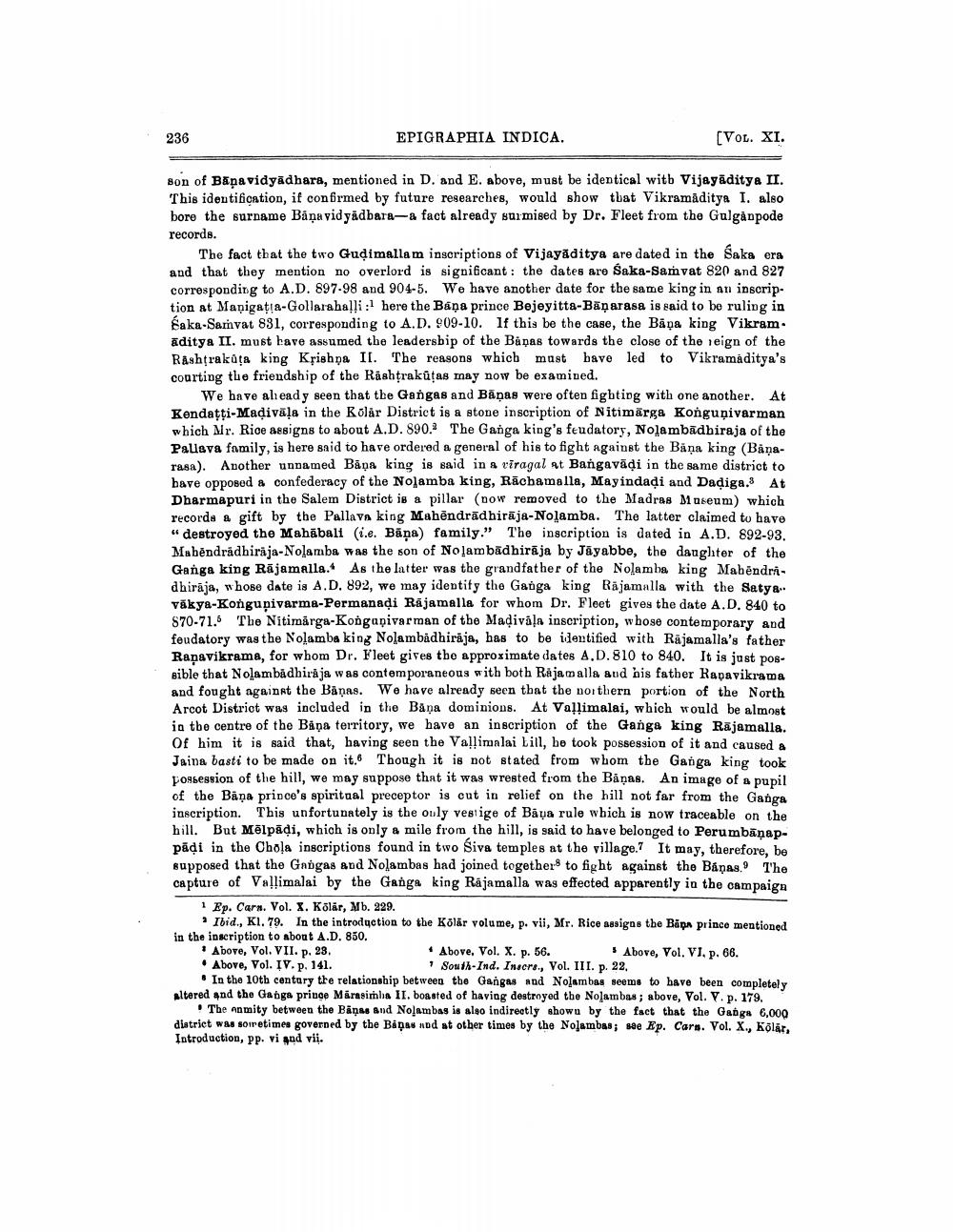________________
236
EPIGRAPHIA INDICA.
[Vol. XI.
son of Bapavidyadhara, mentioned in D. and E. above, must be identical witb Vijayāditya II. This identification, if confirmed by future researches, would show that Vikramaditya I. also bore the surname Baņayid yadbara-a fact already sa mised by Dr. Fleet from the Gulgänpode records.
The fact that the two Guļimallam inscriptions of Vijayāditya are dated in the Saka era and that they mention no overlord is significant : the dates are Saka-Samvat 820 and 827 corresponding to A.D. 897-98 and 904-5. We have another date for the same king in an inscription at Mapigatia-Gollarahalli :1 here the Bāņa prince Bejeyitta-Bāņarasa is said to be ruling in Šaka-Samvat 831, corresponding to A.D. 909-10. If this be the case, the Bāņa king Vikram. aditya II. must have assumed the leadersbip of the Baņas towards the close of the reign of the Rashtrakúta king Krishna II. The reasons which must bave led to Vikramaditya's courting the friendship of the Rashtrakūtas may now be examined.
We have already seen that the Gangas and Bāņas were often fighting with one another. At Kendaţti-Madivāļa in the Rolår District is a stone inscription of Nitimārga Konguộivarman which Mr. Rice assigns to about A.D. 890.The Ganga king's feudatory, Nolambadbiraja of the Pallava family, is here said to have ordered a general of his to fight against the Bäņa king (Bāņarasa). Another unnamed Bāņa king is said in a viragal at Bangavāļi in the same district to have opposed a confederacy of the Nolamba king, Rācbamalla, Mayindaļi and Dadiga. At Dharmapuri in the Salem District is a pillar (now removed to the Madras Museum) which recorda a gift by the Pallava king Mahendrādbirāja-Nolamba. The latter claimed to have " destroyed the Mahābali (i.e. Bāņa) family." The inscription is dated in A.D. 892-93. Mabendrädhiraja-Nolamba was the son of Nolambadhirāja by Jāyabbe, the daughter of the Ganga king Rajamalla. As the latter was the grandfather of the Nolamba king Mabēndridhiraja, whose date is A.D. 892, we may identity the Ganga king Rajamalla with the Satya. vákya-Kongupivarma-Permanadi Rajamalla for whom Dr. Fleet gives the date A.D. 840 to 870-71. The Nitimärga-Kongapivarman of the Madivaļa inscription, whose contemporary and feudatory was the Nolamba king Nolambadhiraja, has to be identified with Räjamalla's father Ranavikrama, for whom Dr. Fleet gives the approximate dates A.D.810 to 840. It is just possible that Nolambadhiraja was contemporaneous with both Rajam alla and his father Rapavikrama and fought against the Baņas. We have already seen that the northern portion of the North Arcot District was included in the Baņa dominions. At Vallimalai, which would be almost in the centre of the Båņa territory, we have an inscription of the Ganga king Rājamalla. Of him it is said that, having seen the Vallimalai Lill, he took possession of it and caused a Jaina basti to be made on it. Though it is not stated from whom the Ganga king took possession of the hill, we may suppose that it was wrested from the Baņas. An image of a pupil of the Bana prince's spiritual preceptor is cut in relief on the hill not far from the Ganga inscription. This unfortunately is the only vestige of Baưa rule which is now traceable on the hill. But Mēlpādi, which is only a mile from the hill, is said to have belonged to Perumbāņappādi in the Chola inscriptions found in two Siva temples at the village. It may, therefore, be supposed that the Gangas and Nolambas had joined togethers to fight against the Baņas. The capture of Val?imalai by the Ganga king Rajamalla was effected apparently in the campaiga
1 Ep. Carn. Vol. X. Kõlar, Mb. 229.
Ibid., Kl. 79. In the introduction to the Kolár volume, p. vii, Mr. Rice assigas the Bapa princo mentioned in the inscription to about A.D. 850. . Above, Vol. VII. p. 23.
* Above. Vol. X. p. 56.
Above, Vol. VI. p. 66. Above, Vol. IV. p. 141.
South-Ind. Inscrs., Vol. III. p. 22, • In the 10th century the relationship between the Gangas and Nolambas seems to have been completely Altered and the Ganga prince Mārasimla II. boasted of having destroyed the Nolambas; above, Vol. V. p. 179.
. The enmity between the Baņas and Nolambas is also indirectly showu by the fact that the Ganga 6,000 district was soiretimes governed by the BADAH nod at other times by the Nolambas; she Kp. Cars. Vol. X., Kõlar, Introduction, PP. vi end vii.




